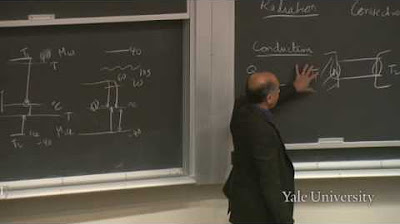The Physics of Heat: Crash Course Physics #22
TLDRThe script explains heat transfer and thermodynamics concepts like temperature, thermal energy, specific heat, and latent heat. It describes how heat flows via conduction, convection, and radiation. The key point is that clothes help retain body heat that would otherwise be lost too quickly to the cooler surrounding air. Clothes trap warm air close to the body, slowing convective heat loss, and provide enough insulation to offset radiative heat loss, keeping the body warm.
Takeaways
- 😀 Thermal energy is the total kinetic energy of all the molecules in a system.
- 😃 Heat is the energy transferred between systems due to temperature difference.
- 😊 Specific heat is the amount of heat needed to change a substance's temperature.
- 🤓 Latent heat is required to change a substance's phase, like melting ice.
- 😯 Heat transfers via conduction (molecular contact), convection (stirring), and radiation.
- 🤔 The amount of heat radiated depends on temperature to the 4th power.
- 🧐 Water has a very high specific heat compared to other substances.
- 😲 During phase changes, heat goes into changing phases not temperature.
- 🤨 Clothes trap warm air close to the body to reduce convection heat loss.
- 😀 The Stefan-Boltzmann equation describes heat radiation over time.
Q & A
What is the difference between temperature and thermal energy?
-Temperature measures the average kinetic energy of individual molecules in a substance. Thermal energy (also called internal energy) is the total kinetic energy of all the molecules in a system added together.
How is heat defined in thermodynamics?
-Heat is the energy transferred between systems that are at different temperatures. It is represented by the symbol Q.
What are the three main ways heat spreads?
-The three main ways heat spreads are: conduction, where heat flows due to direct contact between molecules; convection, where heat flows due to the bulk movement of warmer molecules; and radiation, where heat flows via electromagnetic waves.
How does the amount of heat radiated relate to temperature?
-The amount of heat radiated is proportional to the object's temperature raised to the fourth power. So doubling the temperature causes the heat radiated to increase by a factor of 16.
What happens when heat is added to ice at 0 degrees Celsius?
-When heat is added to ice at 0 degrees Celsius, the temperature stops rising because the heat goes into melting the ice instead. This is called the heat of fusion.
What is specific heat?
-Specific heat is a measure of how well a substance can store heat energy. Substances with higher specific heats require more heat to change their temperature by a given amount.
How does thermal conductivity affect heat conduction?
-Materials with higher thermal conductivity values conduct heat faster because they allow heat to flow more readily between molecules.
Why does convection require bulk fluid movement?
-In convection, heat transfer occurs due to the large-scale motion of warmer fluid rising and cooler fluid sinking to take its place. This allows continual heating of new fluid.
Why do clothes help keep us warm?
-Clothes trap warm air close to the body, reducing heat loss from convection. They also provide enough insulation so the body's heat production can keep up with heat loss from radiation.
What causes phase changes when heat is added?
-Latent heat is required to change a substance's phase from solid to liquid or liquid to gas. Adding heat goes into phase changing rather than temperature rise during these transitions.
Outlines
🌡 How heat flow relates to temperature and phase changes
This paragraph explains concepts like thermal energy, heat, calories, joules, specific heat, latent heat, heat of fusion, and heat of vaporization. It discusses how heat transfer relates to temperature changes in a system, with heat input represented by Q. It highlights that during phase changes, heat transfer depends on the latent heat rather than causing a temperature change.
😀 Three main ways heat spreads: conduction, convection, radiation
This paragraph distinguishes between three main mechanisms of heat transfer - conduction through direct molecular contact, convection via circulation and bulk flow, and radiation through electromagnetic waves. It covers factors affecting conduction like temperature difference, cross-sectional area, thermal conductivity. It also explains dependencies of radiation on temperature, emissivity constant, area based on the Stefan-Boltzmann equation.
Mindmap
Keywords
💡Thermodynamics
💡Temperature
💡Thermal Energy
💡Heat
💡Specific Heat
💡Latent Heat
💡Conduction
💡Convection
💡Radiation
💡Clothes
Highlights
First significant highlight text
Second notable highlight text
Third innovative method introduced
Fourth theoretical contribution highlighted
Fifth notable impact discussed
Transcripts
5.0 / 5 (0 votes)
Thanks for rating:





